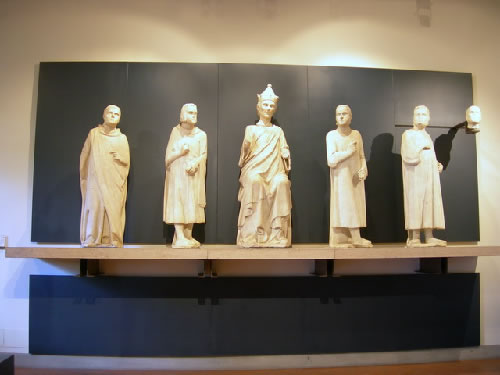PISA SEARCH ENGINE
Among the sculptures stand the works of Tino Camaino and Giovanni Pisano, including the Virgin and Child in ivory sculpted by Giovanni in 1300 for the high altar of the Cathedral.
In the halls of the Treasury there are many relics of the seventeenth and eighteenth centuries and some medieval artefacts including that which is said to contain some rocks of Golgotha and the hermit's habit of San Ranieri, patron of the city. There are also preserved paintings from the fifteenth to the seventeenth century, a series of wooden marquetry from the ancient choir apse, a collection of sacred vestments and a collection of Etruscan, Roman and Egyptian. The latter were collected in the nineteenth century by Carlo Lasinio, which made the nearby Camposanto the first museum of the city. Work of Lasinio are also colored prints watercolor representing the frescoes of the Cemetery in their original appearance, prior to damage suffered during the Second World War.
From the cloister of the museum you can enjoy a splendid view of the Leaning Tower.
History Museum of the Opera del Duomo of Pisa
The building was built as the residence of the Cathedral canons in the late twelfth century. It was made up of two bodies of rectangular factory, brick, willing to elle and delimiting a cloister. Parts of the building are still visible today, especially in the intersection of the two branches where there is still a frescoed vault dating back to that period. At the beginning of the seventeenth century it was transformed into a Diocesan Seminary by Bishop Carlo Antonio Dal Pozzo. He was responsible for the current fašade of Florentine imprint, on which stand out clear plaster, sandstone profiles, windows and the two symmetrical portals. In 1784, he is transferred seminar in Piazza Santa Caterina, the building passed into private hands: sold erudite and art collector Giovanni Rosini, was home for a short time the Pisana Academy of Fine Arts. In 1887 he returned to being a religious building becoming nunnery: the snaturanti changes that ensued were eliminated in the last restoration that began after the Opera of the Primatial, in 1979, he bought the building to convert it into a museum.
Museum dell'Opera of the Duomo Pise
Share page:


